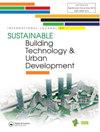为建筑物节能措施融资——一种新的评估方法
Q4 Engineering
International Journal of Sustainable Building Technology and Urban Development
Pub Date : 2015-04-23
DOI:10.1080/2093761X.2015.1025448
引用次数: 2
摘要
我们这一代人努力为可持续建筑提供下一个关键的垫脚石,在经济上可行的情况下提供节能措施。选择和实施简单的能源效率措施(EEMs)来减少能源使用并变得更加可持续,这是很简单的。更复杂的措施正在不断改进,并有更大范围的财政选择。做出正确的长期选择是困难的,英国市场仍然持怀疑态度。本文的研究结果表明,风险和不确定性是制约企业大规模采用电子医疗设备的两个关键因素,因此提出了一种新的长期评估方法。能源效率价值矩阵(EEVM)由以下功能驱动因素组成:成本、灵活性、维护、节能和产品采购。在这些标题下,建筑物业主可以考虑任何EEM,并做出更明智的选择。从住宅到商业建筑,……本文章由计算机程序翻译,如有差异,请以英文原文为准。
Financing energy efficiency measures in buildings – a new method of appraisal
Our current generation strives to provide the next crucial stepping stone towards sustainable buildings, delivering energy efficiency measures without compromise in ways which are financially viable. Selecting and implementing simple energy efficiency measures (EEMs) to reduce energy use and become more sustainable can be straightforward. More complex measures are under continuous improvement and have a greater range of financial options. Making the right long-term choice is difficult and the United Kingdom (UK) market remains sceptical. The results of this paper show that risk and uncertainty are the two key factors that inhibit wholesale adoption of EEMs and as a result a new method of long-term assessment is proposed. The Energy Efficiency Value Matrix (EEVM) consists of the following functional drivers: Cost, Flexibility, Maintenance, Energy Saving and Product Sourcing. Under these headings a building owner may consider any EEM and make a more informed choice. From residential to commercial buildings,...
求助全文
通过发布文献求助,成功后即可免费获取论文全文。
去求助
来源期刊

International Journal of Sustainable Building Technology and Urban Development
Engineering-Building and Construction
CiteScore
1.20
自引率
0.00%
发文量
0
期刊介绍:
The International Journal of Sustainable Building Technology and Urban Development is the official publication of the Sustainable Building Research Center and serves as a resource to professionals and academics within the architecture and sustainability community. The International Journal of Sustainable Building Technology and Urban Development aims to support its academic community by disseminating studies on sustainable building technology, focusing on issues related to sustainable approaches in the construction industry to reduce waste and mass consumption, integration of advanced architectural technologies and environmentalism, sustainable building maintenance, life cycle cost (LCC), social issues, education and public policies relating to urban development and architecture .
 求助内容:
求助内容: 应助结果提醒方式:
应助结果提醒方式:


